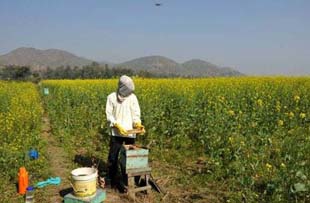Zero Tillage Cultivation of Rapeseed-Mustard in Rice Fallow Enhanced Income in NEH Region
Oilseed cultivation in the NEH region faces several constrains, such as water scarcity during post-monsoon season, lack of irrigation facilities, short time lag after rice harvest for seed sowing and high incidence of pests and diseases in late sown crops As a result, only monocropping of rice is practiced and the farmers leave their land fallow.
The Directorate of Extension Education, Central Agricultural University, Imphal in collaboration with Directorate of Rapeseed-Mustard Research, Bharatpur implemented an extension project for augmenting rapeseed-mustard production of tribal farmers of these states for sustainable livelihood security under the Tribal Sub-Plan (TSP) during rabi, 2011.
Yield performance of rapeseed varieties M-27 and TS-36, yellow sarson, Ragini and mustard varieties Pusa Agrani, Pusa Mahak, NRCHB-101 and NPJ-112 were evaluated in 55 ha under zero tillage cultivation and compared with crops grown in 40 ha under conventional tillage. Besides, use of four bee colonies/ha during crop bloom for pollination, spray of botanical pesticides without affecting pollinators and production of organic honey were demonstrated.
Since there was no rain throughout the crop period, the growth and yield parameters in all the rapeseed-mustard varieties were better in zero tillage than conventional tillage due to residual soil moisture after rice harvest. Among the rapeseed varieties, yellow sarson, Ragini gave the maximum average yield of 10.0 q/ha (range: 8.0 to 14.0 q/ha), whereas, NRCHB-101 among mustard varieties gave maximum average yield of 10.2 q/ha (range: 8.0 to 11.0 q/ha) both under zero tillage cultivation.
In all, 172 farmers across nine villages of Imphal East District enhanced their income by getting average net profit of Rs. 27,388/ha including cost of honey within 105 days with a low investment of Rs. 13,412/ha. Motivated by the success altogether 1,419 farmers across 50 villages in 10 districts of Manipur, Mizoram and Arunachal Pradesh adopted this technology and the area coverage under zero tillage cultivation of rapeseed-mustard increased to 1010 ha during rabi, 2012 and 2013.
Under the water stress situation where there was no rainfall during the crop period of rabi, 2012, M-27 among rapeseed varieties and YSH-401 among yellowsarson varieties and NRCHB-101 among mustard varieties gave maximum average yield of 6.0, 10.0 and 11.9 q/ha respectively under zero tillage cultivation.
Similarly, during rabi, 2013 under the water stress situation, TS-38 among rapeseed varieties, YSH-401 among yellow sarson varieties and NRCHB-101 among mustard varieties gave average yield of 7.9, 9.5 and 11.8 q/ha, respectively under zero tillage cultivation.
The present success story in the farmers’ field indicates that rapeseed-mustard is a climate resilient crop which can be grown without water in the residual soil moisture. By adopting zero tillage, the farmers could increase the productivity, reduced cost of cultivation, increased the cropping intensity and earned an additional income with less effort. Zero tillage also helps in timely sowing (October-November), conserves soil moisture and requires less water, saves tillage cost and time and the soil is protected from erosion due to the retention of surface residues and reduce organic matter depletion.
The improved version of this zero tillage cultivation with bee pollination and no chemical method of plant protection may be recommended to the resource poor farmers of the north eastern region in the context of climate change.
(Source: Central Agricultural University, Imphal and Directorate of Rapeseed-Mustard Research, Bharatpur)


